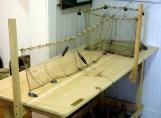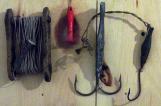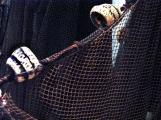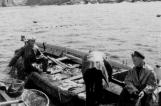2
There were many different methods of fishing used in Newfoundland. In the earliest days, hand-lining (the use of a single, baited hook and line) was most commonly used. A weight made of a heavy material, usually lead, would be added to the single hand-line when fishing with a baited hook. This weight would ensure that the hook would sink deep into the water near the bottom.4
Jiggers, hooks set into lead shaped like a small fish, were also used on single lines. Used without bait, they were pulled up and down to tempt the squid or cod to take the hook. Sometimes the hook would catch into the body of the cod. The dabber (similar to a jigger but usually lighter in weight with a single hook set into lead) could be used like a jigger, or could be used with bait.5
Fishing trawl and tub2003
Winterton Boat Building and Community Museum, Newfoundland and Labrador, Canada
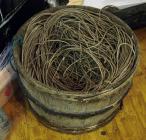
6
Another method of fishing, which yielded a greater catch, was trawling. The trawl was a long line that had attached to it many short lines with hooks at their ends. Each hook would be baited as a section of the trawl was put into the water. The trawl was stored and transported in a large wooden tub.7
Baiting the trawl (left to right): Eliol Hiscock, Reg Rose and Roland Hiscock1960
Winterton, Newfoundland, Canada
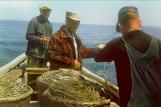
8
The process of putting the trawl line into the water is referred to as setting the trawl. It was important to ensure the trawl was set at bottom (or close to the bottom) in the best location on the fishing ground. This was usually around a ridge or shoal of rocks where the fish congregated. Trawls set close to the shore were shorter in length and were sometimes moored in place for several weeks while codfish were in the area. The catch would be removed and the hooks re-baited daily.10
Nets were also used for certain types of fishing. The caplin seine was used to catch caplin for bait. One haul each evening would provide all the fishermen with bait for the next day.11
Cod trap model made by Alfred Green of Winterton2003
Winterton Boat Building and Community Museum, Newfoundland and Labrador, Canada
